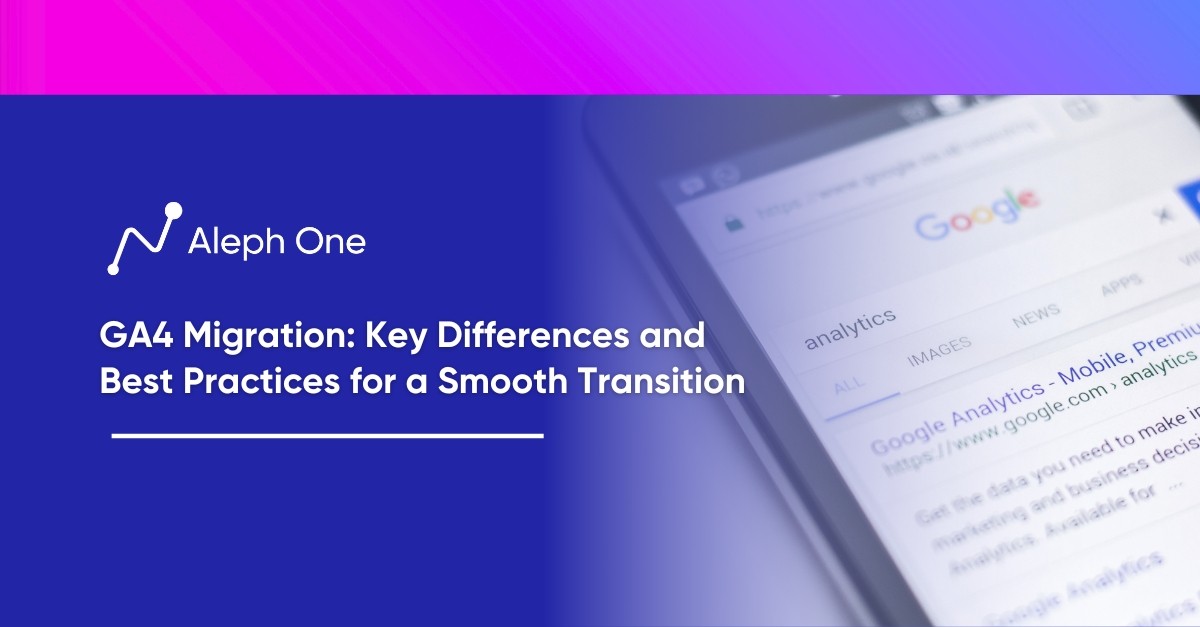Let’s work together to build something amazing. Share your project details and our team will reply to figure out the next steps to your success.

As the deadline for Universal Analytics (UA) deprecation looms, businesses urgently need to migrate to Google Analytics 4 (GA4). With UA’s data collection and processing ending on July 1, 2023, any company still relying on it after June 30, 2023, will lose access to their analytics data and insights. This article explores the critical differences between UA and GA4, the challenges associated with the migration process, and the best practices to ensure a seamless transition. From understanding the unique data models to mastering the step-by-step migration process and running both systems in parallel, this guide offers valuable insights to help businesses harness the power of GA4 and safeguard their data-driven decisions.

The Impending Sunset of Universal Analytics: Why You Need to Migrate Now
Google has announced that Universal Analytics (UA) will be deprecated on July 1, 2023. After this date, UA will no longer collect or process data, and all historical data will be deleted. Any company still using UA after June 30, 2023, will lose access to all their analytics data and insights.
Safeguard Historical Data and Analytics
The implications of losing years of historical data and analytics are huge. Companies will no longer be able to analyze trends over time, optimize based on past performance, or make data-driven decisions using their UA data. The only way to avoid disruption and continue leveraging Google Analytics is to migrate to the new Google Analytics 4 (GA4) platform as soon as possible.
What is GA4?
GA4 is Google’s next-generation analytics platform that provides an updated data model, a modern interface, and new features not available in UA. While GA4 has significant benefits, migrating from UA requires time and resources to implement properly. Companies must migrate their data, rebuild reports and dashboards, update tracking, train teams, and more. The earlier you start the migration process, the more time you have to address any issues, and the smaller the risk of data loss or reporting gaps.
Companies Delayed in Migrating to GA4
Some companies have delayed the migration due to a lack of awareness around the UA deprecation timeline or uncertainty about what is required to move to GA4. However, waiting too long to migrate puts businesses in a dangerous position where they may not be able to fully transition before the UA sunset date. Any company still on UA must make migrating to GA4 an immediate priority to maintain access to their data and analytics. The time to start planning and implementing your GA4 migration is now.
UA will no longer be available starting July 1, 2023, and all data will be removed. Migrating from UA to GA4 requires significant effort and time, so companies must begin the process as soon as possible to minimize disruption and data loss. An early start to your migration is critical to mastering the move to GA4 before the UA sunset.
Key Differences Between UA and GA4 You Need to Know
Universal Analytics (UA) and Google Analytics 4 (GA4) have some significant differences in their data models, features, and reporting that you need to understand before migrating.
Data Models Differ
The data models differ in that GA4 has a simplified model with only a few core objects: events, users, and audiences. UA has a more complex model with profiles, views, metrics, dimensions, and segments. GA4 events replace UA pageviews and screen views. User properties in GA4 replace custom dimensions in UA.
GA4 Increased Focus on Event-based Data
GA4 has an increased focus on event-based data and user behavior analysis. It provides more granular control over events and parameters. The flexible event schema allows you to track events that matter to your business. However, GA4 currently lacks some functionality from UA, like content groupings, internal site search, and goal flows.
Reporting Interfaces
The reporting interfaces are quite different. GA4 has a simplified interface with a focus on customization. The standard reports in UA, like Audience, Acquisition, and Behavior, are not available in GA4. Instead, you build customized reports from scratch based on your needs. GA4’s Analysis Hub provides an easy way to analyze your data but may require a learning curve.
Historical Data
For many clients, the differences in historical data have been the most significant challenge. GA4 only provides 14 months of historical data compared to UA, which can have over a decade of data. This can impact the ability to create benchmarking or long-term trend analyses. However, for some clients with less historical data reliance, the fresh start provided by GA4 has been an opportunity to reevaluate their data strategy and improve data quality.
Understanding how these differences will impact your unique needs and processes before starting your migration is key. Running UA and GA4 in parallel for some time can help determine key variances in your data and identify strategies for mitigating potential disruptions. With proper planning and preparation, you can ensure a smooth transition to GA4.
A Step-by-Step Process for Migrating Your Data and Components
The first step in migrating from UA to GA4 is enabling the new GA4 property and linking it to your existing UA property. This will allow GA4 to access historical data from UA for migration. Next, you need to migrate your users, which includes their identifiers, attributes, and consent settings. Check that user counts and attributes are consistent between UA and GA4 to ensure complete migration.
Migrating Events and Event Parameters
Migrating your events and event parameters is one of the most critical steps. Map your UA events to equivalent events in GA4 and test to ensure all parameters are captured correctly. Look for differences in the total number of events reported between UA and GA4 and troubleshoot any issues.
Audiences
Audiences in GA4 are built differently than in UA, so you’ll need to rebuild them from scratch. Pull a list of your UA audiences and create corresponding audiences in GA4 based on the same membership criteria. Compare audience sizes to verify they have migrated accurately.
Goals
Goals in GA4 are also configured differently, so you must set up new goals and map them to your existing UA goals. Check that goal completion numbers and conversion rates are consistent to confirm the correct configuration.
Custom Dimensions and Metrics
Custom dimensions and metrics will need to be rebuilt in GA4. Pull a list of your UA custom dimensions and metrics and create them in GA4 with the same scope and parameters. Double-check that reports relying on these custom fields are calculated properly after migration.
Ecommerce Tracking
Ecommerce tracking must be reimplemented in GA4 using the new ecommerce data model. Test ecommerce transactions to ensure all data is being captured accurately in reports. Look for discrepancies in metrics like revenue, transactions, and average order value.
Roll-up Reporting and Dashboards
Roll-up reporting and dashboards will need to be rebuilt in GA4. Compare new GA4 reports and dashboards to UA to confirm metrics and dimensions are correctly calculated. Check for any data discrepancies and make adjustments to GA4 components as needed.
With proper testing and troubleshooting at each step, migrating your data and components from UA to GA4 can be achieved smoothly. However, it does require time and resources to execute fully. Running UA and GA4 in parallel after initial migration is recommended to gain confidence in the data before sunsetting UA.
Best Practices for Running UA and GA4 in Parallel
Running Universal Analytics (UA) and Google Analytics 4 (GA4) in parallel for a period of time is highly recommended during the migration process. This phased approach provides several benefits:
Compare Data Between the Two Systems
By running UA and GA4 simultaneously, you can analyze discrepancies in key metrics, dimensions, and reports. This helps uncover how the differences between the platforms impact your data and identify where adjustments may need to be made to instrumentation or reporting. For example, one client found that their pageview counts were significantly lower in GA4 than UA due to differences in how the platforms track single-page app traffic. Discovering these insights during the parallel tracking period was critical to optimizing their data in GA4.
Train Your Teams on the New Interface
The GA4 interface is quite different from the UA interface, so providing time for your teams to learn how to navigate the new reports, dashboards, and tools is essential. Circulate documentation and run training sessions on how data is structured and accessed in GA4. This will ensure a smooth transition once you fully migrate to GA4.
Update Integrations and Exports
If you have any systems that integrate with or export data from UA, additional time is needed to update them to connect to GA4. Work with the vendors and developers of these systems to switch the data source from UA to GA4. This includes updating APIs, data layers, and any scripts that pull data from UA.
Gradually Transition Stakeholders
Rather than abruptly switching over to GA4, a gradual transition where both systems are available allows stakeholders to get accustomed to the new reports and metrics at their own pace. Provide guidance on where key metrics and dimensions can now be found in GA4. This more gradual approach helps reduce disruption and leads to higher adoption of the new platform.
Running UA and GA4 in parallel and taking a phased migration approach is the best strategy for mastering your move to GA4. By analyzing the differences, training your teams, updating integrations, and gradually transitioning stakeholders, you will fully understand how your data and analytics processes will be impacted before fully migrating to GA4. This methodical process helps ensure a seamless transition to GA4 with minimal disruption.
Overcoming Common Migration Challenges
One of the biggest challenges companies face when migrating from UA to GA4 is the loss of historical data. GA4 only retains data for 14 months, so any data before that will not migrate. For companies that rely heavily on trend analysis or benchmarking, this can disrupt essential reporting and analytics processes. The best approach is to analyze historical UA data before migrating and save reports or insights that you want to refer to in the future. Also, consider whether 14 months of data will be sufficient for your needs in GA4 or if you need to adjust data retention settings.
Broken Integrations
Broken integrations are another common issue, as the APIs and data models differ between the two platforms. Any systems that ingest or automate your UA data, like data warehouses, customer data platforms, or marketing automation tools, must be updated to work with GA4. It is best to inventory all integrations early on and plan for resources to update each one. In some cases, integrations may need to be rebuilt from scratch. Allow plenty of time and budget for this process.
GA4 Mission Certain Functionalities
Some companies also find that GA4 lacks certain functionality they rely on in UA. While GA4 is improving rapidly, it may still be missing some features you need. Consider whether any missing features are critical to your business or if there are acceptable workarounds. You can also check the GA4 roadmap to see if any key features are planned for release in the coming months. For critical features, you may need to keep UA running side by side with GA4 until the functionality is added.
With the right planning and preparation, companies can overcome these common challenges and migrate from UA to GA4 smoothly. Performing analysis of historical data, inventorying and updating integrations, and evaluating any functionality gaps early on will help you identify potential issues and have strategies in place to address them. With a phased migration approach, you can migrate data and components gradually while running UA and GA4 in parallel to minimize disruption. With some patience and the help of experts, migrating to GA4 can be a seamless process.
A Checklist for Mastering Your Move to GA4
Migrating from Universal Analytics to GA4 is a complex process that requires careful planning and execution. To help ensure you cover all necessary steps, here is a comprehensive checklist:
Pre-migration Preparation
- Determine your migration timeline and key milestones. Build in extra time for unforeseen challenges.
- Audit your existing UA implementation to understand what needs to be migrated. Document properties, views, goals, audiences, filters, and integrations.
- Plan how to migrate historical data and whether you need to maintain UA access for trend analysis.
- Train your team on GA4 features, data model, and reporting ahead of the migration.
- Choose a migration tool like the GA4 Migration API or 3rd party ETL platforms to transfer data. Test the tool before migrating live data.
Data Migration
- Migrate users and events first to capture ongoing data in GA4. Then migrate historical data.
- Recreate audiences, goals and filters in GA4 and test them thoroughly.
- Migrate dashboards, scheduled reports, and email alerts to GA4. Double check all are functioning properly.
- Update all integrations and tag management solutions to point to the GA4 measurement ID. Test each integration before relaunching.
Report Configuration
- Build all key GA4 reports and dashboards for your teams. Replicate UA reports as closely as possible.
- Provide GA4 report training and documentation for all teams with analytics access.
- Continue analyzing both UA and GA4 reports in parallel to identify and fix any discrepancies.
Ongoing Management
- Monitor your GA4 data and reports regularly to ensure all is functioning properly. Address any issues immediately.
- Continue providing GA4 support and training to your teams as needed. Update documentation with any changes.
- Review new GA4 features as they are released and determine if they can provide value. Implement as needed.
- Plan to fully sunset UA at least 3-6 months after migrating to GA4 to allow for stabilization and parallel analysis.
Plan Accordingly and Use GA4 for Your Startup
With diligent planning and collaboration across teams, migrating from UA to GA4 can be achieved smoothly and successfully. This checklist provides guidance for every phase of your migration to help you master your move to GA4.
What are the key differences businesses should be aware of between Universal Analytics (UA) and Google Analytics 4 (GA4)?
The key distinctions between UA and GA4 largely regard their data models, features, and reporting. GA4 has a simplified data model with core objects: events, users, and audiences, whereas UA hosts a complex model with profiles, views, metrics, dimensions, and segments. GA4’s focus on event-based data and user behavior analysis leads to more granular control over events and parameters, although some of UA’s features, like content groupings, internal site search, and goal flows, are not present in GA4. Another significant difference hinges on historical data; UA can store over a decade of data for trend analysis, but GA4 limits data to the past 14 months. Therefore, businesses must understand how these differences will impact their unique needs and processes before migrating.
Could you identify and explain some common challenges businesses might encounter during the migration process from UA to GA4?
Some common challenges businesses might face during the migration include the loss of historical data, broken integrations, and a lack of certain functionalities in GA4 currently available in UA. GA4 only holds data for 14 months, which might disrupt reporting and analytics processes for companies that rely heavily on trend analysis or benchmarking. Broken integrations stem from differences in APIs and data models between the two platforms, necessitating updates for any systems that ingest or automate data from UA. Lastly, while GA4 is improving quickly, some necessary features in UA might be missing, necessitating parallel running of both platforms for certain businesses until those key features are added to GA4.
What are the best practices for running UA and GA4 in parallel?
Running UA and GA4 in parallel is recommended for the following reasons: to compare data between the two systems and uncover potential discrepancies that might affect your data; to train your teams on the new interface, reducing friction during migration and ensuring a smooth transition; to update integrations and exports, allowing enough time for developers and vendors to switch the data source to GA4; and to gradually transition stakeholders to the new systems, reducing disruption and spurring the adoption of the new platform. The benefits gleaned from this phased approach dovetail with mitigating disruptions and maintaining the integrity of your data analytics processes.
Get the latest news and updates from Aleph One in your inbox.



